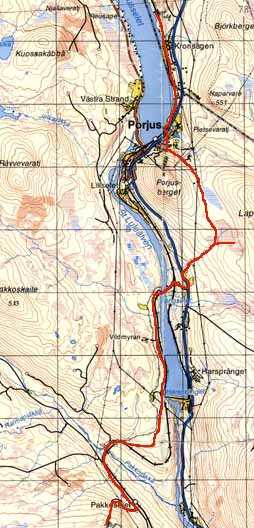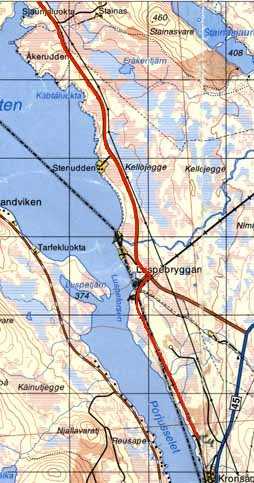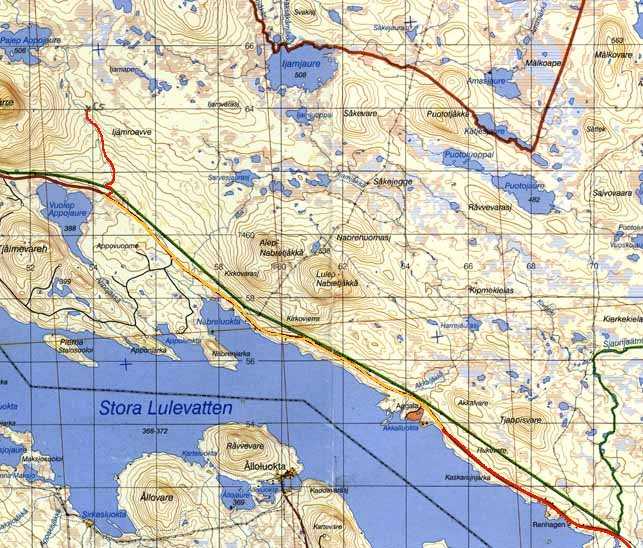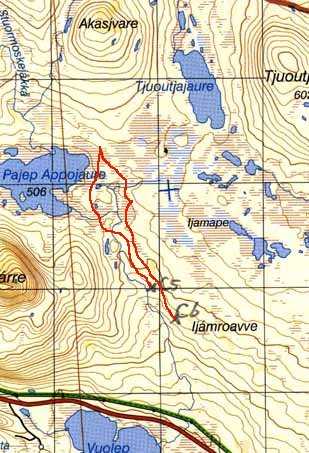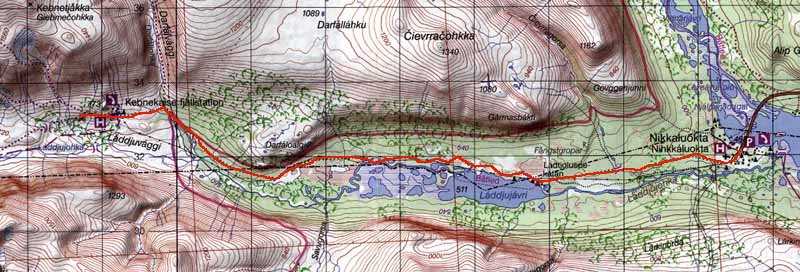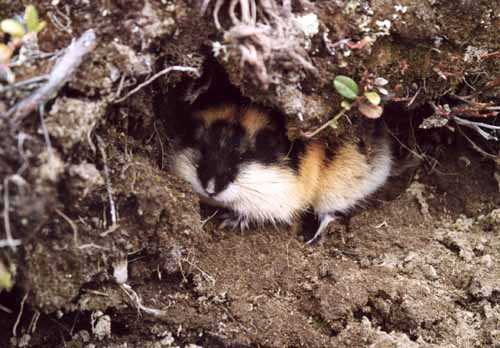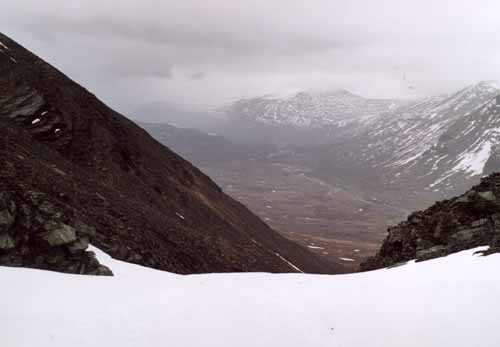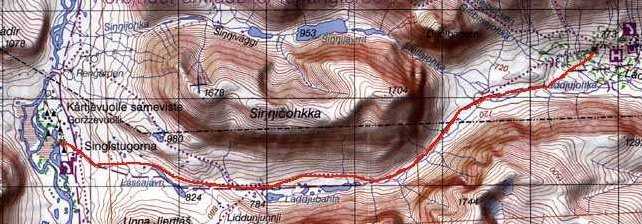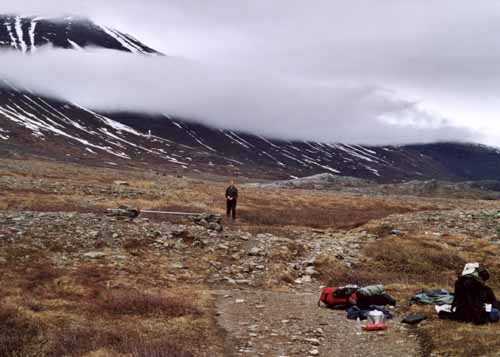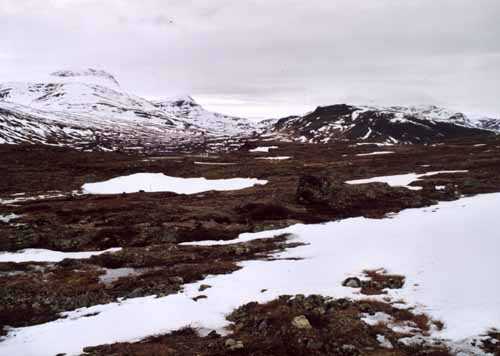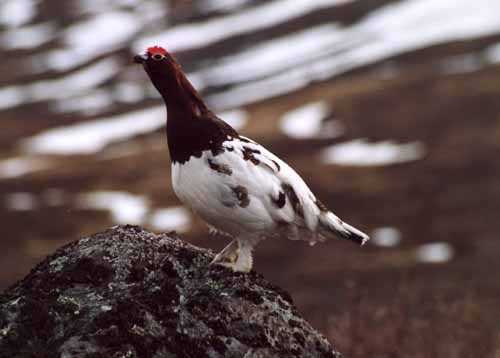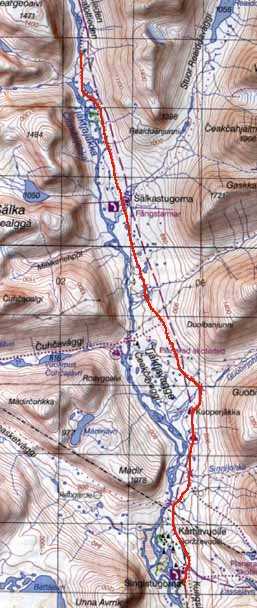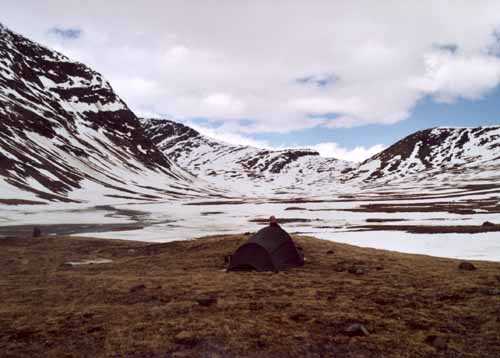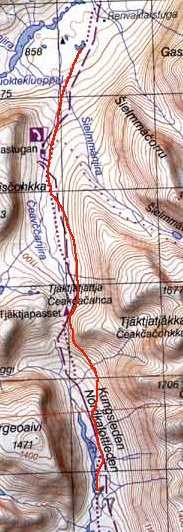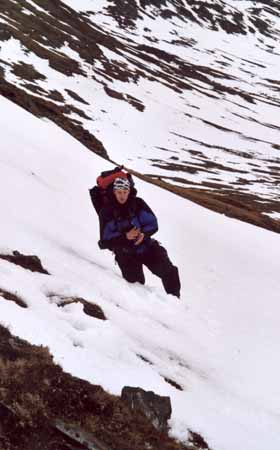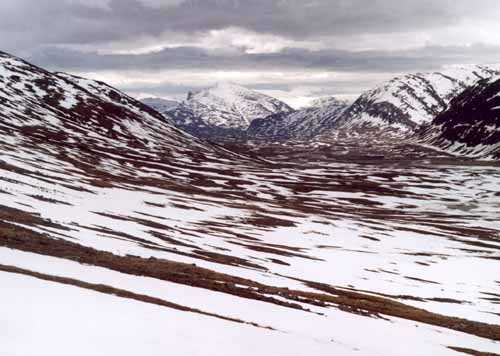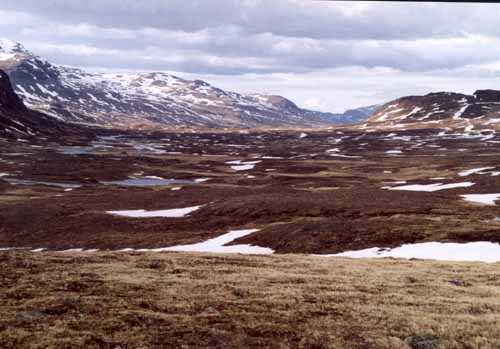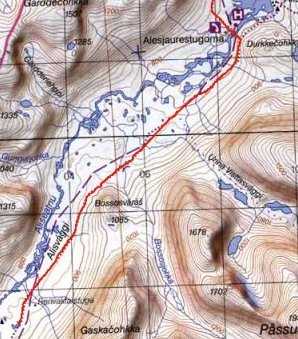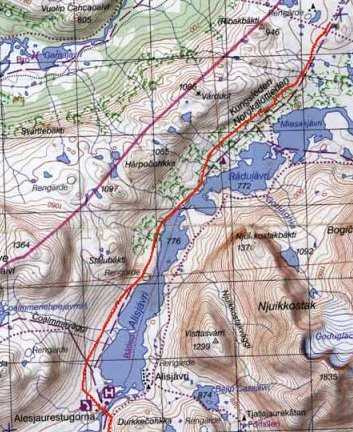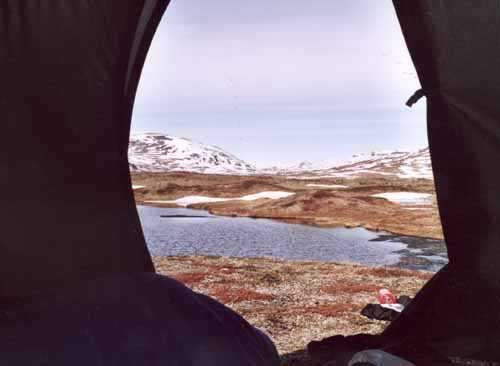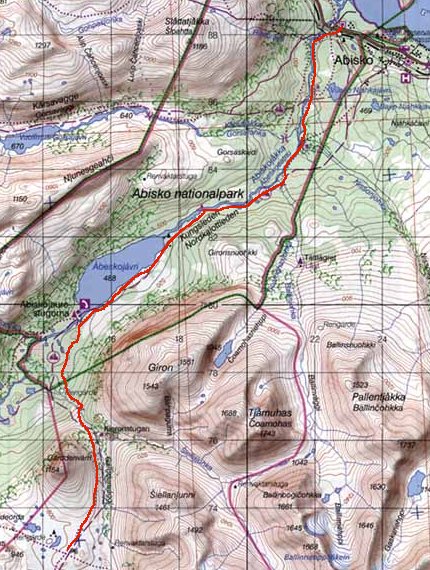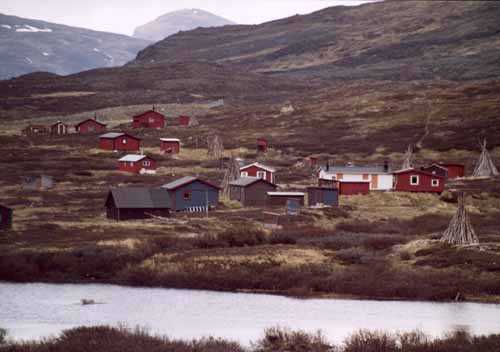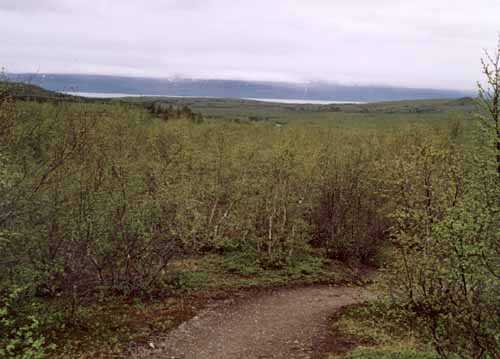SaLEx 2001
In October 2000 I got an SMS from Ruben, a friend of mine, on my mobile phone. It said that he wanted to go hiking in Sweden with me in the summer of 2001. He was at that time working on a research project in South Africa and I was for a birding trip on Schiermonnikoog. As he stayed there until April most of the arrangements were done via the internet. We had to do the hike in spring as I had to leave for Spitsbergen the end of June.
The moment I received the SMS the Kungsleden came into my mind. This is the most famous trail in Sweden and is about 440km long. When I checked this out on the internet it turned out that we were too early for this trip. We would have to cross several lakes with the Kungsleden. Because of the time of year, most of these lakes would still be partially frozen and the small boats used later on in the season would not be present yet. Therefore we decided to make our own trail. We planned to walk from Jokkmokk (just above the Arctic Circle) to Abisko, in Abisko national park. In this way, we could avoid the big lakes, and only had to cross some small streams. Because of all the lakes, we had to cross or to walk around, we baptized our trip the Sápmi Lake Expedition, or SáLEx for short. Sápmi is the official name for the country of the Lapps. The trip would lead us first through nice forests and the last part we would pass the fjells, treeless mountain area’s. There were several problems with this trail. First of all, it was not a marked trail, we actually didn’t even know if there were any direct roads between the two villages. We thought we would be able to walk with a map and compass, even if there were no roads (and we didn’t have any experience with both). The second problem was that we wouldn’t find many villages with shops on our way. This meant that we would have to take all the food for the whole trip (ca. 3 weeks) with us. The last problem (as we could see at that time) would be that we were really early in the season. This meant that there was still a lot of snow on the mountains, there was a lot of meltwater in the streams and all the mountain huts (that could provide us with food) were still closed. In spite of these problems, we were still determined to try it, and see how far we would make it.
- the route: We walked from Jokkmokk to Sjaunja (70km) and from Nikkaluokta to Abisko (105 km) and some around Abisko (70km). For this total of 250km, we needed 17 days of walking (including one day on the slopes of the Kebnekaise).
- Difficulty: Due to the off-road hiking and the amount of snow the hike was tough. Now and then we had to make our way through thigh-deep snow or cross a stream. We avoided high mountains (apart for a short attempt to climb the Kebnekaise) but had to do some climbing now and then. The highest point reached was about 1200m.
- markings: none. We walked sometimes over well-defined paths, and sometimes with the aid of a map and compass. We used the following maps: Blå Kartan 27J (Porjus) and 28J (Fjällåsen) and Fjällkarta BD6 (Abisko-Kebnekaise-Narvik) and BD8 (Kebnekaise-Saltoluokta). The latter wasn’t needed for the trip as we did it eventually but would be needed for walking all the way from Jokkmokk to Abisko.
- accommodation: Tent. In Sweden, it is allowed to pitch up your tent where ever you want, as long as it is more than 150m away from any buildings, which was never a problem for us. Later in the season (and earlier), the mountain huts are open, and one can sleep there.
supplies: According to our original plan we would only have shops in Jokkmokk, Porjus and Abisko. Therefore we brought food for 3 weeks with us. Due to the change in plans, we had additional opportunities to resupply in Gällivare and Kiruna. Later in the season (and earlier), the mountain huts are open and one can buy some food there as well. - season: The trip would be much easier later in the season. Then almost all the snow would have melted down, the mountain huts would be open and the streams would be smaller. One big disadvantage of walking later in the season is the abundance of mosquitoes at that time. We hardly saw any.
- Nature: We arrived at the beginning of spring, with most trees still leafless. Most birds, however, were already present. Of the typical taiga bird species, we saw Siberian Jay, Siberian Tit and Arctic Redpoll (all only one time). Most common bird species were Bramblings and Red-spotted Bluethroats. It was really nice to see the Fieldfares breeding (and feeding their young) in leafless trees. Of the mammals, we saw Moose and Reindeer (not the wild one), but we saw tracks of much more species. Fortunately, there were hardly any mosquitoes.
27-05-2001 Jokkmokk – Vajkijaur
After all the preparations we got started in Umeå. There we relaxed and partied some days before taking the bus to Jokkmokk, where we arrived in the evening. Here was the starting point of our trip. The maps showed that we would have to walk without paths for a large part of the trip. This meant that we had to make our own trail through the forests and fjells, something to look forward too. The first day we started easily with just walking out of Jokkmokk and leaving the car roads behind us. It was really cold and we started to regret not to bring any gloves with us. But the scenery was really nice, even though we still walked in a populated area. We put up our tent above a small village, Vajkijaur. When we put up our tent it even started snowing, not hard, but still… We warmed ourselves at a campfire, in which we also burned some of our most hated study books, which made us feel really good.
28-05-2001 Vajkijaur – C2
We woke up late this morning, as we needed some sleep after the journey to Jokkmokk and the parties in Umeå. Because of this, we started walking only at noon. We walked on roads made for forest keepers but didn’t see anyone at all. While walking we saw lots of Common Redstarts and finches, mainly Bramblings. During an early lunch, we saw a displaying Rough-legged Buzzard. After this, we had our first little part of off-road hiking. We had to cross a piece of forest in between 2 roads. This was our first experience with walking with only the guide of a map and compass. This worked out quite okay. We had some problems with a swampy part, but we managed to end on the other road again. There we saw a completely white bird flying away from us. It turned out to be a Willow Grouse. On the road, we saw a lot of animal droppings and tracks. Ruben was especially interested in the latter as he had just returned from a research project in South Africa on herbivores. That included for a large part looking and identifying animal droppings, something he continued here. We found droppings and footprints of Moose, Reindeer, a fox and some cat-like animal. But the best were the footprints of a Brown Bear. They were a little smaller as the Polar Bear tracks I know from Spitsbergen. We walked through the forests all day and therefor kept an eye open for the typical taiga bird species. We were rewarded for this with a Siberian Tit. Unfortunately, it was gone before I could take a picture of it. But it was a nice bird. Soon after this, we pitched up our tent close to a nice forest stream. After dinner, we went for a small walk and heard some displaying Black Grouse. Unfortunately, we didn’t see them and by the time I had my microphone ready they were silent again.
29-05-2001 C2 – Pakkoselet
This morning we packed a little faster already and after I shaved in really cold water we started walking. We were just on our way when we heard a strange bird calling. This time I was able to record it and it turned out to be a Raven, the same bird as we saw flying just after the strange sound. We had nice weather with sun and soon we took off some clothes. Today we had to follow a small dashed line on the map, which we thought was a tractor trail. Later on, we saw that a dashed line also had another meaning, an unused and unmarked footpath. The trail we followed got smaller and smaller and soon we lost the path completely. Fortunately, we still knew our position on the map, so our “knowledge” of the use of a compass was in our favour again. Now and then we saw some half-rotten wooden boards used on places where it was really swampy. This meant that we were still on the right track. But most of the time we only had our map and compass as a guide. Despite this, we did really enjoy our walk. It went through nice forests with now and then some more open and wet parts. In those wet parts, we saw several Wood Sandpipers and Yellow Wagtails. For crossing these wet parts we had to use our gaiters, as it was really wet sometimes. In the forest, we saw again large numbers of Brambling. Now and then we had to cross small streams, but we managed to do so without large problems. We followed this “path” the whole day, now and then retrieving the original tracks again, but most of the time creating our own trail. In the afternoon we had to climb a hill and from there we had a nice view of the landscape ahead. We now knew that we were still heading in the right direction. When we walked downhill we suddenly found the track back, and this time it didn’t disappear anymore. We had to cross our first small snowfields and again were very pleased that we brought gaiters with us, as this kept out most of the snow. The trail leads us to the exact place we wanted to reach. As soon as we were back on a broader road we pitched up our tent. We had not walked a real long distance, but walking off-road takes more time as walking on a footpath. Ruben immediately started to make a fire to celebrate that we made it (or was it just for fun?). When we were in our tent we realised that we hadn’t seen a single soul in the past 1.5 days.
30-05-2001 Pakkoselet – Porjus
After the struggle through the forest of yesterday, we had quite an easy day. We could follow broader car tracks again, fortunately still without any other humans. In the forest next to our tent we saw and heard the Bramblings and “Greater” Redpoll again. When we just got started we saw some more Bear tracks. After a while, we had to follow the Luleälv for a while. We saw Red-breasted Mergansers and Common Goldeneyes swimming in the river. When we crossed it we saw our first of many Red-spotted Bluethroats. I didn’t know that they as well had a display flight like a Wood Lark. Shortly after this, we saw the first cars and humans after almost 3 days. Now we had to follow another tractor path, which started clearly indicated. But unfortunately, the path got smaller and smaller until we were completely lost again. After bringing our compass-reading-experience into action we managed to find the right trail again. Somehow it came into my mind that we would make it to Porjus (the last village we would see in days probably) in the evening. And with that, I only could think of the food and Hamburgares that were waiting for me there. Unfortunately, the distance was a bit longer as I expected and Ruben already wanted to stop. But we couldn’t find any drinkable water, needed for cooking, so we decided to continue walking until we reached Porjus. It was already getting late, and it became more and more doubtful if the supermarket (if they had one) would still be open. It turned out that we were just in time for the supermarket, that we plundered for peanuts, fruit, candies and dried stuff. It has turned out that we had too little lunch with us, and this could be the last re-supply possibility. After this, we went to the Hamburgare and ordered a Skrovmål stor, the biggest hamburger we could find there. And big it was. We had problems with eating it all and afterwards we had to sit and wait for 30 minutes until the food was digested enough so we could continue walking. We now followed a railroad, which wasn’t really good walking. The sleepers were not nice and evenly spread so we were fed up with it really soon. As it was getting late already we also wanted to stop, but we couldn’t find any nice flat place to pick up our tent. Eventually, we found a small place along the railroad that was flat enough for our tent. Here we had a look at the program for the next day. We had to walk for two days on a car road and we decided to try to hitchhike that part or take a bus.
31-05-2001 Porjus – Sjaunja
We woke up from a service train running right next to our tent. Fortunately, that was the only thing that we saw on the railroad the whole morning. We walked for an hour on the railroad and promised ourselves that this would be the last railroad to walk on for our entire life. At Lyspebrugga we could leave the railroad and there we could walk on a normal road again. Because we couldn’t find any bus stop and car traffic was scarce, we decided to start walking and hitchhiking on our way. We walked next to a big lake, where we heard Red-throated Diver and saw Whooper Swans. Flying over the road we saw an Osprey and a Common Buzzard, later on, a Common Sandpiper and some “Greater” Redpolls. After several hours walking over the hot asphalt, we finally got a ride. The ride maybe took us 20 minutes, but it saved us at least one day hiking. They dropped us off at a small stream. We would follow this stream for a while. We now entered the nature reserve of Sjaunja. We had read in a guide about Sjaunja: “This area is not for the faint-hearted backpacker”. This was a statement that only increased our interest in this area. That we could meet up with Brown Bear, Lynx, Wolverine and Wolf only added to this. Unfortunately, there were no roads through this area, so we had to set our own trail for the next 2 weeks or so. In the beginning, we did very well. We could follow the stream and some Moose tracks which made walking pretty easy. On a nice hill, we stopped to pick up our tent. The scenery was really nice here, with nice lichens and nice views through the forest. And we could again wash in the 1° C water of the streams. We were now at such a high latitude that it didn’t get dark anymore at night. The sun still set, but even with the sun below the horizon, there was enough light to see everything. The advantage of being here so early in the season was that there were no mosquitoes at all. We had enough mosquito repellent with us to exterminate the whole Swedish mosquito population, but fortunately, we didn’t have to use it at all.
01-06-2001 Sjaunja
Today we walked the whole day through the forest. We always tried to walk over Moose tracks, as they made a sort of trail that was quite easy to follow. First, we could follow the stream, but after a while, we had to cross it. This turned out not to be as easy as we expected. It was quite broad and deep, with a strong current. After a while, we found some trees that had fallen over the stream that we used as a bridge. When we walked at the other side it turned out that we had crossed the stream too early! Now we had to cross 2 more streams. Nevertheless, nature was very beautiful. We saw several Grey-headed Wagtails and Red-spotted Bluethroats. Now there was only one problem rising. We didn’t walk by far what I estimated when I planned the trip. And at this speed, it would be doubtful if we made it in time to Abisko. As we had already problems with the crossing of the streams so far it was doubtful if we made it over the streams later on. These streams had a significant wider blue line on the map as the streams we have crossed so far. Just before lunch, we had a nice view of the landscape. We had some nice forest ahead, on the background snow-covered mountains were waiting for us. We had another look at the map, and recalculated the distances ahead and how many days it would take. The result was very disappointing: as we could see now we had exactly enough days to make it to Abisko, but it meant that we had to walk for almost 20 days in a row, without any rest. And if we had any other new problems, we wouldn’t make it in time. And the problem was that there were no shortcuts or places where we could get on the bus before Abisko. So if something went wrong we had to walk all the way back. Therefore we decided to turn around and try to find some other trail to walk. This meant that we gave up our original plan already on the 5th day, something that wasn’t really good for my mood. While walking back (not on exactly the same road of cause) I started thinking of plan B. At the moment we decided to pitch up our tent and dropped our backpacks on the ground I grabbed for the maps. I had figured out plan B! We would hitchhike to Gällivare, go to Kiruna, take the bus to Nikkaluokta and pick up the track to Abisko again. This shortcut would save us many days of struggling through forest and swamps. Now we could resume the hike further down our intended trail. Only crossing “Nikkaluokta-Lake” was not feasible via the original route. This problem was however solved now. From here we would walk along the slopes of Swedish highest mountain, the Kebnekaise, and then walk part of the Kungsleden and the Nordkalottaleden to arrive in Abisko. With this plan, our mood immediately improved and we could sleep without problems again.
02-06-2001 Sjaunja – Gällivare
Today we packed our tent for the last time in Sjaunja. Instead of walking here for more than a week, we would leave already after 2 days. But we were both confident that we had taken the right decision. We followed another Moose track this time. Until now we still hadn’t seen any real wildlife. Ruben was the first to see something, but that “big dark thing with 4 legs” was too fast to be identified. Somewhat later I saw my second wanted taiga species, the Siberian Jay. After only an hour walking we were back on the car road again at the same spot that we left less than 2 days ago. This time we didn’t want to walk all the way, so we just waited 2.5 hours and 5 cars, before someone stopped and wanted to give us a lift. He brought us to a more used car road and there we got a lift within half an hour to Gällivare. There we were right in time for the disco.
05-06-2001 Kiruna – Nikkaluokta – Kebnekaise
After two days of rest, we continued walking again. First, we took the 5:30 bus from Kiruna to Nikkaluokta. Well, we thought that it would leave at 5:30. It was 5:45 when the bus arrived with a very sleepy bus-driver and with a broken ticket machine, so we couldn’t pay. The bus driver told us to pay on our way back, he didn’t know that we wouldn’t go back but walk to Abisko instead. We didn’t tell him. We arrived early in Nikkaluokta, everyone was still asleep, or not present yet as the mountain station would only open in a week. This day we could walk on nice broad paths again, without too much difference in height. This footpath is often used to walk to the slopes of Kebnekaise in summer. This is what we used it for as well. As it was such an easy walk we walked fast. We walked through a low birch forest, again with a lot of Bramblings and Red-spotted Bluethroats. Now and then we had to cross a small stream, but this time there were bridges available. On our way, we saw lots of Lemming and some Snow Hares. We had lunch close to a bigger river. Along the shores we saw and heard Reed Bunting, Willow Warbler and, of cause the Bluethroat again. On the water, we saw a pair of Black-throated Divers and some feeding Arctic Terns. Just after lunch we made a small walk, without backpack, and saw a nice Short-eared Owl flying, a species I didn’t expect to find here. We walked now through a valley with steep mountains on each side, one of which being the Kebnekaise, Sweden’s highest mountain with 2111m. We had decided that we would try to climb it, even though it was really early in the season, and there would be lots of snow on the summit. Just before the Kebnekaise Mountain station, we saw 2 Moose walking, the first ones of this trip. When we tried to take a picture we also saw some Wood Sandpipers and a Willow Grouse. At the mountain station, we heard that there was indeed lots of snow on the Kebnekaise, but that it was possible to climb it. But we were a bit sceptical because we didn’t bring any mountaineering equipment. We decided to try it and to see what would be possible for us. We put up our tent just after the mountain station and went to bed early.
06-06-2001 Kebnekaise
For some reason, I didn’t sleep well this night, so I didn’t really start well for our Kebnekaise ascent. This was already noticeable when we were just started and we were walking a little uphill. My legs didn’t want to move at all, and I was really tired already. After a while, we came to the real beginning of the mountain, the first snowfield. We put our gaiters on and started climbing. It soon came apparent that we wouldn’t make it to the top, this snowfield was already too much for me this day. Ruben didn’t have any problems and was walking far ahead of me. Halfway the snowfield we met a group hikers coming from above. They had climbed the Kebnekaise yesterday and had slept in a hut close to the top. It took them 9 hours to make it to the top. This was something we hadn’t really count on, a night at the top. Now my mood decreased even more and at the top of the first snowfield, I didn’t see the use of continuing anymore. I stopped and sat down on a rock. While I sat there and drank some melted snow I saw a Ptarmigan passing. After a while, Ruben noticed that I wasn’t following him anymore and walked back to the place I had stopped. We drank some more melted snow and returned to the tent again. The way down went much easier as the way up, as we could just let us slide down over the snow. At the tent, I immediately crawled into my sleeping bag and slept for some hours. At dinner, I discovered that not only Bluethroats have a Woodlark like display flight, but Wheatears too. In the evening we went for a small walk again. Here we found some Whrimbels, a pair of Long-tailed Jaegers and 3 Reindeer.
07-06-2001 Kebnekaise – Singistugorna
After an easy day and good night sleep, we continued fresh again. This was a really rainy day. We woke up with rain, packed our stuff in the rain and walked in the rain. This was not really a problem at the beginning, although it isn’t nice to pack things when it’s wet. After a while, we saw another nice Long-tailed Jaeger. We walked into another valley, that was a bit higher as the previous. This meant that we had to cross some snowfields. Twice I sank until my middle into the snow. This and the rain filled my shoes completely with water. I could hear the water dunk in them. This wasn’t really good as we still had to walk for 10 days before we would reach Abisko. While walking through the valley we saw several Ptarmigans and even one more Short-eared Owl. It was nice to see the separation between Willow Grouse and Ptarmigan. When we were walking in an area with trees and bushes we only saw Willow Grouse, and now, above the tree-limit, we saw only Ptarmigan. At the end of the afternoon, when it dried up a little, we arrived at Singistugorna. We decided to pitch up our tent here and to use the dry period to dry our clothes a little. We pitched up our tent close to a river, where a Willow Grouse was posing for us. After dinner it started to rain again, so we decided to go to bed again.
08-06-2001 Singistugorna – Tsjäktja
Our shoes were a little drier as yesterday evening, but far from completely dry. And it was still raining, and above this, we also had a storm. Fortunately, we had the wind in our back. Again we had to cross several snowfields. As this doesn’t walk very nice we decided not to take the detour over the Nordkalottenleden. We knew now that the mountains above 900 meters were still snow-covered and that detour would give us several days over 900 meters. And with our wet shoes, we didn’t want to try that. We decided to walk straight to Abisko, get some rest and dry our stuff there and then walk back to Nikkaluokta through a different (and lower) valley. Just when we were completely fed u with the rain and our soaking wet shoes, nice birds appeared out of nowhere. We saw Dotterel, Lapland and Snow Bunting, Temminck’s Stint and Red-necked Phalarope. It was really nice to see the latter trying to walk and feed on the snow in the storm. At Sälkastugorna we had some lunch in one of the huts. We decided to walk on for a while as it didn’t look like the weather would improve soon. Now we met more and more snowfields, which assured us that we made the right decision to walk straight to Abisko. Something that wasn’t nice was the view ahead. We saw our valley getting smaller and smaller, ending in a not so low pass. I thought that we didn’t have to climb anymore. A look on the map told us that the pass was Tsjäktja and was about 1100m high, a little disappointing. But the pass was too far away to reach today, so we pitched up our tent on one of the last snow-free patches before the pass. We were camping now in a storm and completely surrounded by snow, a special experience. Around us we saw Long-tailed Jaegers flying, they seemed to like the storm. Due to the cold, we didn’t spend much time outside, but cooked inside and went to bed.
09-06-2001 Tsjäktja
When we woke up and looked out of our tent we saw that the snowfield was still waiting for us. In contrary to the previous day it looked more like one big snowfield with small snow-free patches. And the wind was still as strong as the day before. It took a while before we had packed everything without it being blown away. We had lost the path again, but this time we didn’t need a map or compass to tell us where to go. The pass was clearly visible. We decided to walk a little higher up along the sides of the valley, to prevent walking through small streams. Some days before us 2 other people had walked the same path, and now and then we could follow their footprints. This time we lost them, but there were lots of other ways to climb the pass. Now we had to walk and climb over and mainly through snowfields. Ruben weighted a little bit less as me and didn’t sink through the snow as often as I did. Often I sank through the snow until my thighs. When I just worked myself on top of the snow again I sank through again… This was very exhausting, but we had to continue. Most of the time Ruben walked in front as he was better in walking uphill. Once I took over, but I had to wade through the snow most of the time so Ruben couldn’t really use my trail. One time I got stuck in the snow, with both legs completely buried. The only way to get out was to tumble over with my backpack on my back. Ruben must have looked really surprised when he saw me suddenly rolling over. Under these extreme circumstances, we didn’t see much wildlife. The only birds we saw were some Snow Buntings and Long-tailed Jaegers. The most surprising was the footprints of an animal. Later we learned that they belonged to a Lynx! Somehow we got the idea that when we made it to the top we would see a nice green valley ahead of us. It was very disappointing to see that this wasn’t the case and that even more snow was waiting for us. It was around noon when we arrived at the top of the pass and we had lunch in the small hut that was available there. We had a nice soup there, with the pemmican we brought. It looked weird but tasted really good and finally, we didn’t have to eat peanuts as an addition. Here we saw the footprints of our mysterious people ahead of us. We were doubting on how to continue walking. The safest was following the edge of the valley as we didn’t run the risk of a sudden stream under us. But this would mean a big detour and that wasn’t a pleasant sight through all the snow. The footprints were running straight through the valley taking almost the shortest way. We decided to follow these prints again. This time this turned out to be a bad decision. We ran right into a stream that was running through the snowfield. The top layer was normal snow and the next layer (of about half a meter) was water-saturated snow. The water was now running right into our, already wet shoes. We turned around and tried to reach a little snow-free patch again. Ruben took off his shoes to let the water run out of it. We now walked a little higher, a way that our predecessors took as well, as it turned out. My shoes were soaked and looked like some subtropical swimming pool. The only wildlife we saw was a pair of Rough-legged Buzzards displaying in the air. The snow was so soft now that even Ruben sank through it all the time. We were wading through the snow now all the time. After several hours we arrived at our green valley. We now thought that we had all problems behind us, but the biggest problem was still to get. There were still some snowfields to cross, but nothing that looked serious from a distance. When we came closer to one, we saw that it was a field with a big stream through it. There was no “bridge” over the stream anymore, only some snow on each side. But the stream was too big to jump over without standing on the snow. And we couldn’t see how thick and stable the snow was. We jumped over at the place where the distance was the smallest and where our predecessors had jumped as well. But when Ruben was on the other side, he saw that the snow was very thin at that place. But he couldn’t find any place that was more save, so I jumped there as well. Fortunately, this was the last obstacle for the day. Now we could walk on the Kungsleden again. We pitched up our tent close to a small lake, that was still partly frozen. On the lake, we saw several Ruffs, some Temminck’s Stints and some really tame Red-necked Phalaropes. We had a nice evening with a small fire, enjoying the nice and dry weather. We also saw some Bluethroats and Short-eared Owls again.
10-06-2001 Tsjäktjastugan – Alesjaure
We woke up and started with what we ended the previous day, enjoying the birds and weather again. When we started walking we also saw some Long-tailed Ducks. Today the walking was much easier, with only very view snowfields, where we didn’t sink through. We saw much more birds as the previous day again. Willow Grouse, Common Gulls, Bluethroats and Snow Buntings were seen again. At Alesjaurestugorna we had lunch. Now we walked next to the lake Alesjaure. We walked through some scrubs again. In the scrubs we saw more birds again, Red-spotted Bluethroat and Mealy Redpoll being the most common. Apart from the birds we also saw some people again, the first since the ones we saw at Kebnekaise. Once I saw some really white Redpolls with a white rump patch: Arctic Redpoll! Unfortunately, they were gone the moment I had my camera available. At that time it started raining again as well, so we continued walking again. We walked over 20km this day as we wanted to walk as close as possible to the edge of Abisko National Park, so we could make it to Abisko the next day. We camped some kilometres after Alesjaure close to a Samenviste. There we saw some Reindeer, probably of the herd of the Sami living next to us.
11-06-2001 Alesjaure – Abisko
When we woke up it rained again. We decided to stay in bed until it would get dry. This took a while, and we wanted to reach Abisko today, so at 10 o’clock we started packing. At this time it stopped raining. We descended more and more and the trees got higher. Soon we arrived at the border of Abisko National Park. Soon after this, we were walking along the shore of Abiskojaure. On the lake, we saw Velvet Scoters and Long-tailed Ducks. It was really nice to walk through a real forest again. Here spring had just started as well. We saw some flowers and some of the trees had already leafs. Along the shores, we saw Common Sandpipers, Whrimbels and Grey-headed Wagtails. Now we also saw different people again. In the afternoon we reached Abisko, where we went to the campsite. We didn’t really like campsites, but in this case, it was nice. We could use the sauna and had a nice place to dry our clothes and shoes. We decided to stay there for some time.
14/17-06-2001 Abisko – Alesjaure – Abisko
We wanted to walk back to Nikkaluokta through the valley of Visttasvaggi. This valley was much lower as the one we came through so we didn’t expect much difficulties. We had to walk back for two days to Alesjaure. When we arrived there we met a group of people that came out of the valley that we wanted to walk through. They told us that a bridge over the river was broken and that it was really hard to cross it without. They tried and didn’t make it and another couple was even picked up with a helicopter. So for us, the choice was easy, we would go back to Abisko. On our way back we met several people who wanted to walk to Nikkaluokta and that had heard that there were two Dutch guys who had made it through the Tsjäktapass. We had become famous! And people who tried it all came back because it was too difficult. Another blast for our ego. So we ended after four days walking back in Abisko. We now had some time left, but jumped on the train and went back to Holland, after a nice holiday and a really nice experience.








